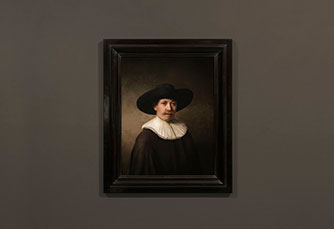Rembrandt goes digital
6 April 2016
After almost 400 years, a new portrait ‘by Rembrandt’ was unveiled in Amsterdam yesterday. The portrait was created by art historians and technicians using data and facial recognition techniques from 346 of Rembrandt’s paintings.
After almost 400 years, a new portrait ‘by Rembrandt’ was unveiled in Amsterdam yesterday. The portrait was created by art historians and technicians using data and facial recognition techniques from 346 of Rembrandt’s paintings.
ING, a proud sponsor of the Rijksmuseum, contributed to the project along with several other businesses including advertising agency J Walter Thompson, Microsoft and advisors from Delft University of Technology (TU Delft), The Mauritshuis and Museum Het Rembrandthuis.. The work of art took almost 18 months to complete, consists of 148 billion pixels and was printed in 3D.
Rembrandt van Rijn (1606 – 1669) was one of the world’s greatest painters and an important figure in Dutch history.
Tjitske Benedictus, head of sponsoring at ING Netherlands, said the project was an example of how technology can be used to enhance art and culture.

“At ING we believe in the power of innovation and what it can mean to people. We want to bring this innovative spirit to the sponsorship of Dutch art and culture. We teamed up with many experts from various fields to make this come to life,” she said.
From data to painting.
The first step in the project was to study the works of Rembrandt to establish an extensive database. The analysis showed that the new portrait should be one of a Caucasian male, between 30 and 40 years old, someone with facial hair and wearing dark clothing.
After this, the subject’s features were generated in the style of Rembrandt. A facial recognition algorithm identified and classified the most typical geometric patterns used by Rembrandt to paint human features. It then used the learned principles to replicate the style and generate new facial features for the painting.
Next, these individual features were assembled into a fully formed face and bust according to Rembrandt’s use of proportions. With the help of TU Delft, a height map was created to identify patterns on the surface of canvases. By transforming pixel data into height data, the computer could mimic the brushstrokes used by Rembrandt.
Finally, to bring the painting to life, an advanced 3D printer that is specially designed to make high end reproductions of existing artwork was used. In the end, 13 layers of UV-ink were printed, one on top of the other, to create a realistic painting texture.
All this has resulted in a work of art that portrays the power and the beauty of data and technology and that will fuel the conversation about where innovation can take us.
More details about this unique painting at www.nextrembrandt.com
